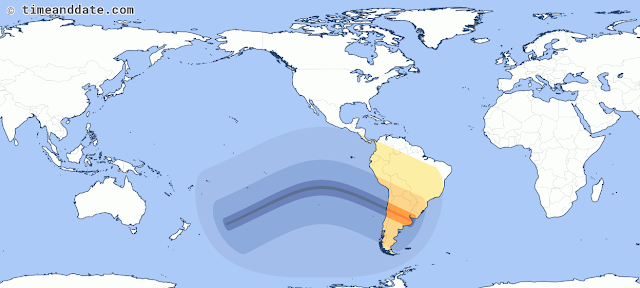| Date | Event |
|---|---|
| July 2 | New Moon |
| July 2 | Total Solar Eclipse |
| July 4 | Mars 0.1°S of Moon |
| July 4 | Mercury 3°S of Moon |
| July 4 | Moon in Beehive (M44) |
If you live in the city of Buenos Aires head south on the 2nd of July to witness the total solar eclipse. This may be a once in a lifetime opportunity for many people and should not be missed. As you can see in the image below the Southern Pacific Ocean chews up most of the totality but it will still hit some fairly high population areas towards the winter sunset.
 |
| July 2, 2019 Total Solar Eclipse |
 |
| Solar Eclipse from Calgary, August 21 2017. |
Next week we can look forward to Saturn's opposition placing it at its closest and largest in the night sky.
There are two rocket launches scheduled for next week. A Soyuz Rocket will be taking a polar-orbiting weather satellite into space from the Vostochny Cosmodrome in Russia. The next day a Vega rocket will take a high-resolution Earth imaging satellite into orbit for the UAE's military.
| Date | Event |
|---|---|
| July 4 | Soyuz - Meteor M2-2 (23:41) |
| July 5 | Vega - Falcon Eye 1 (19:53) |
What is exciting is that the Royal Astronomical Society of Canada and the Calgary Public Library are teaming up to bring Calgary an amazing Astronomy Program. We will be visiting every branch around the city for a one hour program all about the night sky.
We will talk about some famous constellations that can be seen during the Summer, the Moon, the Solar System and we will have a hydrogen-alpha telescope on hand to showcase our amazing home star-the Sun. Details can be found at the following webpage:
https://events.calgarylibrary.ca/programs/online-registration?id=7902|1
| Date | Event |
|---|---|
| July 4 | Quarry Park Library (18:30-19:30) |
| July 6 | Giuffre Family Library (14:30-15:30) |
Do not miss this opportunity to freely educate yourselves or your family and friends. We hope to see you out at one of the branches this Summer!










